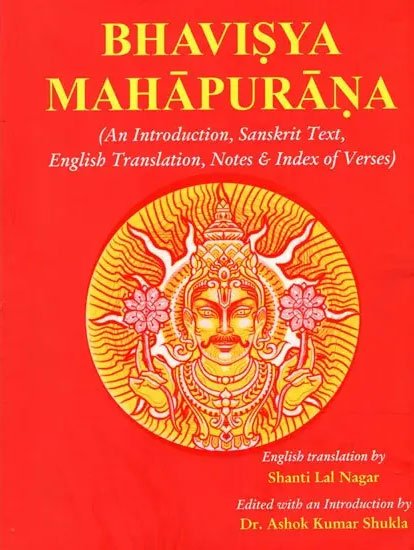Bhavishya Purana [sanskrit]
245,265 words
This Sanskrit edition of the Bhavishya Purana. It is one of the traditional eighteen Mahapuranas presented as an encyclopedia of ancient Indian history and knowledge. The Bhavishyapurana contains 4 books and over 26,000 Sanskrit verses. It is famous for detailing the history and legends of ancient times as well as future times, narrating the genealogy of the kings and sages. The last part is considered an independent work known as the Bhavishyottara-Purana.
Verse 1.1.30
व्यास उवाच ।
तस्यैतद्वचनं श्रुत्वा व्यासो वचनमब्रवीत् ।
एष शिष्यः सुमन्तुर्मे कथयिष्यति ते प्रभो ॥ ३० ॥
vyāsa uvāca |
tasyaitadvacanaṃ śrutvā vyāso vacanamabravīt |
eṣa śiṣyaḥ sumanturme kathayiṣyati te prabho || 30 ||
The Sanskrit text of Verse 1.1.30 is contained in the book Bhavishya Purana: Sanskrit Text with Hindi Translation by S. N. Khandelwal. This book is not available online so in order to read the full text and translation you should buy the book:
Buy now! Sanskrit text by S. N. Khandelwal (2022)
Glossary of Sanskrit terms
Note: This extracts Sanskrit terms and links to English definitions from the glossary, based on an experimental segmentation of verse (1.1.30). Some terms could be superfluous while some might not be mentioned. Click on the word to show English definitions.
Vyasa, Cana, Vacana, Esha, Shishya, Sumantu, Asmad, Kathayishyat, Tad, Yushmad, Prabhu,
Analysis of Sanskrit grammar
Note: this is an experimental feature and only shows the first possible analysis of the Sanskrit text (Verse 1.1.30). If the system was successful in segmenting the sentence, you will see of which words it is made up of, generally consisting of Nouns, Pronouns, Verbs, Participles and Indeclinables. Click on the link to show all possible derivations of the word.
- Line 1: “vyāsa uvāca ”
- vyāsa* -
-
vyāsa (noun, masculine)[nominative single]
- uvāca -
-
√vac (verb class 2)[perfect active first single], [perfect active third single]√vac (verb class 3)[perfect active first single], [perfect active third single]
- Line 2: “tasyaitadvacanaṃ śrutvā vyāso vacanamabravīt ”
- tasyai -
-
sā (noun, feminine)[dative single]√tas (verb class 4)[imperative middle first single], [imperative passive first single]
- tadva -
-
tadvan (noun, masculine)[compound]
- canam -
-
cana (noun, masculine)[adverb], [accusative single]cana (noun, neuter)[adverb], [nominative single], [accusative single]
- śrutvā -
-
√śru -> śrutvā (absolutive)[absolutive from √śru]
- vyāso* -
-
vyāsa (noun, masculine)[nominative single]
- vacanam -
-
vacana (noun, masculine)[adverb], [accusative single]vacana (noun, neuter)[adverb], [nominative single], [accusative single]vacanā (noun, feminine)[adverb]
- abravīt -
-
√brū (verb class 2)[imperfect active third single]
- Line 3: “eṣa śiṣyaḥ sumanturme kathayiṣyati te prabho ”
- eṣa -
-
eṣa (noun, neuter)[compound], [vocative single]eṣa (noun, masculine)[nominative single]√eṣ (verb class 1)[imperative active second single], [perfect active first single], [perfect active second plural], [perfect active third single]√iṣ (verb class 1)[imperative active second single]
- śiṣyaḥ -
-
śiṣya (noun, masculine)[nominative single]√śās -> śiṣya (participle, masculine)[nominative single from √śās class 2 verb]√śiṣ -> śiṣya (participle, masculine)[nominative single from √śiṣ class 10 verb]
- sumantur -
-
sumantu (noun, masculine)[nominative single]sumantu (noun, feminine)[nominative single]
- me -
-
ma (noun, masculine)[locative single]ma (noun, neuter)[nominative dual], [vocative dual], [accusative dual], [locative single]mā (noun, feminine)[nominative dual], [vocative single], [vocative dual], [accusative dual]asmad (pronoun, none)[dative single], [genitive single]
- kathayiṣyati -
-
√kath -> kathayiṣyat (participle, masculine)[locative single from √kath class 10 verb]√kath -> kathayiṣyat (participle, neuter)[locative single from √kath class 10 verb]√kath (verb class 10)[future active third single]
- te -
-
ta (noun, masculine)[locative single]ta (noun, neuter)[nominative dual], [vocative dual], [accusative dual], [locative single]tā (noun, feminine)[nominative dual], [vocative single], [vocative dual], [accusative dual]tad (noun, neuter)[nominative dual], [accusative dual]sa (noun, masculine)[nominative plural]sā (noun, feminine)[nominative dual], [accusative dual]yuṣmad (pronoun, none)[dative single], [genitive single]
- prabho -
-
prabhu (noun, masculine)[vocative single]prabhu (noun, feminine)[vocative single]
Other editions:
Also see the following editions of the Sanskrit text or (alternative) English translations of the Verse 1.1.30
Complete Bhavisya Mahapurana (English translation)
by Shantilal Nagar (2023)
Publisher: Parimal Publication Pvt. Ltd.; Pages: 2496; ISBN-10: 817110729X; ISBN-13: 9788171107292
Buy now!![Bhavishya Purana [sanskrit] - book cover](/uploads/a/Bhavishya-Purana-Sanskrit.jpg)
